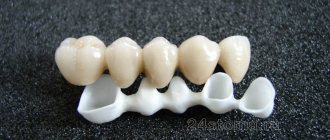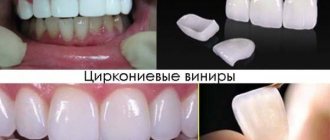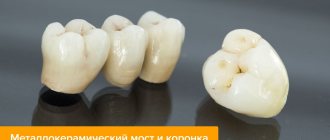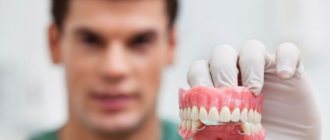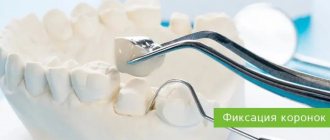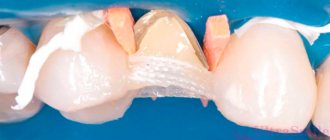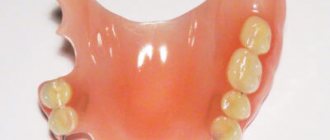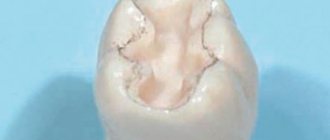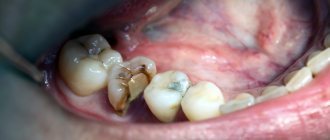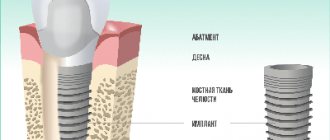From this article you will learn:
- pros and cons of ceramic zirconium crowns,
- their varieties - “Multi-layer”, monolithic, etc.,
- how much does a zirconium crown cost for 2022.
Zirconium crowns are a variant of dental crowns for restoring damaged and missing teeth, the material of which is zirconium dioxide (ZrO2). This material belongs to metal-free ceramics. Unlike metal-ceramics, zirconium dioxide crowns do not have a metal frame inside, which makes it possible to achieve a higher level of aesthetics in dental prosthetics (compared to metal-ceramic crowns).
Zirconium crowns also have very high strength. They are considered to be at least 2-4 times stronger than crowns made from other types of metal-free ceramics (for example, porcelain crowns). But all this is true only for crowns that are made of monolithic zirconium dioxide. In most cases, only the internal frame is milled from zirconium dioxide, on top of which layers of porcelain mass are applied. This allows you to achieve a higher level of aesthetics, but on the other hand, it increases the risk of chipping.
Zirconium crowns: photo
However, in recent years, a new technology for manufacturing zirconium crowns has emerged, which is called “Multi-layer”. This technology makes it possible to produce crowns from monolithic zirconia (i.e., without applying a surface layer of porcelain), and at the same time obtain esthetics almost comparable to the most esthetic types of metal-free ceramics, for example, crowns made of feldspathic porcelain or IPS E-max ceramics.
All this became possible thanks to the emergence of modern versions of zirconium dioxide blocks (disks), which are made using the “multi-layer” technology and also have high transparency (translucency characteristic of natural tooth enamel). In this article we will talk not only about the pros, but also about the disadvantages of ceramic crowns made of zirconium dioxide, and also why reviews of zirconium dental crowns from real patients are very often negative. And you probably already realized that this happens when dental clinics save money on better-quality consumables.
What are the differences between zirconium crowns?
Crowns made of zirconium dioxide are metal-free structures - one of the types of ceramics. Zirconium is a silvery, grayish metal that is obtained from the naturally occurring mineral zircon.
In dentistry today, metal-free structures are widely used to restore teeth. And models made of zirconium or zirconium dioxide are especially popular. The material is obtained from a natural mineral by stabilization with yttrium and enrichment with aluminum. The resulting zirconium dioxide has very high strength, moderate transparency and a white color without shine. Technologies for manufacturing metal-free ceramics appeared relatively recently, but they immediately gained well-deserved popularity among dentists and patients.
Dental material is produced in the form of fairly soft and plastic blank blocks. The best zirconium crowns are obtained from transparent multilayer blanks of the new generation (Katana line of zirconium discs, Kuraray Noritake, Japan, etc.). The required structure is made from them and its final baking is carried out. After this, the model acquires its main properties: high strength and aesthetics. Externally, artificial teeth made of zirconium are almost no different from natural ones.
And yet, until recently, the high strength of zirconium dioxide did not allow the manual production of monolithic structures. This became possible only with the advent of the latest computer technologies CAD/CAM (computer-assisted design and manufacturing), which includes processing patient data using digital scanning, transferring it to a computer and building an accurate model, and finally manufacturing the desired one on a robotic machine. designs. For chewing units, pure zirconium monolithic structures are used, for the anterior ones, they are covered with porcelain ceramics on top.
What is zirconium
Zirconium is the element zirconium (Zr). The periodic table indicates its atomic weight 91.22 and number 40. It is included in food products, stones, and ores.
The compound of zirconium with oxygen is a silver-gray metal. Reminiscent of stainless steel, white gold. Before purification, it often contains radioactive impurities. After removal it must comply with GOST 21907-76. It is opaque, malleable, viscous, resistant to corrosion, is not magnetized, but is attracted by a strong field.
Zirconium in jewelry is used in the form of metal inserts and frames, for the manufacture of earrings.
It is also used for the synthesis of cubic zirconia. These are transparent stones with brilliant clarity and radiance. Dark grey, graphite or black artificial gems are called black zirconium.
Cubic zirconias also come in:
- yellow;
- orange;
- blue;
- red;
- blue;
- green;
- pink;
- purple;
- golden with a brown tint.
Zircon differs from metal in that it is a natural gemstone of the silicate group. It contains the element Zr, which is why the mineral is used to extract zirconium. The color ranges from colorless (Matar Diamond), golden (Siamese), blue (Starlite) and brown (Malacon).
In addition, watch the video review to continue the description of the metal:
Read more about the differences between zircon, zirconium and cubic zirconia in the article.
Indications and contraindications for installation
Zirconium dioxide crowns have indications and contraindications for installation. Indications:
- persistent discoloration of tooth enamel;
- destruction of the natural dental unit as a result of caries, trauma, chipped enamel;
- congenital dental anomalies – shape, height, enamel;
- large interdental spaces (trema), including between the front teeth (diastema);
- installation of a prosthesis on an implant;
- intolerance to other dental materials.
Contraindications for installing zirconium dental crowns:
- severe malocclusion – deep bite;
- bruxism (involuntary grinding of teeth) – the risk of rapid wear of antagonist teeth in the opposite dentition;
- very small teeth;
- increased abrasion of hard dental tissues;
- infectious and inflammatory processes in the oral cavity - prosthetics are allowed only after complete treatment;
- diseases that contribute to a persistent decrease in immunity - diabetes, AIDS, oncological processes;
- severe general illnesses and psychoses;
- pregnancy.
When it is necessary to place crowns made of zirconium, are there any contraindications?
If a patient has diseases of the blood, internal organs or endocrine system and definitely needs a crown, zirconium is the only solution. In addition, indications for installing just such a prosthesis are:
- desire to leave the tooth alive (the root is not removed);
- caries;
- allergy to metal, which means it is impossible to install a metal crown;
- greatly changed enamel color.
There are also some contraindications: pregnancy, small teeth, teeth grinding (relative contraindication).
Types of zirconium dioxide crowns
Zirconium block blank
Three types of blank blocks are produced depending on the degree of light transmission - translucency or translucency:
- With minimal translucency, maximum strength and resistance to stress. They are used to make dentures for people with malocclusion. In the Katana line these are STML blanks.
- With increased translucency, but less strength. They are used when there is a need for prosthetics of individual units. Suitable for prosthetics when color is of primary importance. The Katana NT brand is suitable.
- With very high transparency - ultra-translucent and with fairly high strength. It makes the best designs for front units. Very aesthetic and do not require ceramic coating. In the Katana line, this is the UTML brand.
There are two types of zirconium models - classic with a zirconium frame and completely made of zirconium.
Models with zirconium frame
Double-layer structures made of zirconium coated with phosphorus ceramics
This type is considered classic. These two-layer zirconia crowns feature a metal-ceramic design: a durable frame made from a monolithic zirconia blank, topped with beautiful phosphorus ceramic. The best models for the smile zone; in appearance they are no different from natural dental units.
Such models are installed on the front sections of the dentition, since the aesthetics of the structure are very important here. They are not suitable for chewing units: there is a high risk of chipping on porcelain ceramics.
Monolithic in full anatomy
Monolithic zirconium models in full anatomy
Zirconium dental crowns, made entirely of zirconium dioxide (monolithic), are less aesthetically pleasing, but they are strong and reliable, so they are installed on chewing units. An interesting fact: to give the prosthesis the desired color, it is painted with special bright paints, and after final firing, the model takes on a natural appearance.
Seeing a doctor
You need to make an appointment with a dentist if the following problems occur:
- The installed structure has lost stability;
- There is an unpleasant odor from the mouth;
- An inflammatory process is observed on the gums, pain is felt;
- The crown is installed incorrectly, causes discomfort to the person, and interferes with other teeth;
- The prosthesis fell out.
In addition, you need to visit the clinic for professional preventive cleaning and crown replacement. The service life of such structures varies between 2-15 years, depending on the material of manufacture and compliance with operating rules. Even if the service life of the crown has not expired, it is better to replace it if the color changes or cracks appear. Do not self-medicate, it is better to consult a specialist!
Advantages and disadvantages of zirconium dental crowns
The advantages of zirconium crowns include:
- increased strength, resistance to mechanical loads is a very significant advantage; for this reason they are no worse, and sometimes even better, than metal ones;
- corrosion resistance;
- neutrality in relation to galvanic processes;
- free penetration of X-rays - they do not accumulate in zirconium during diagnostic studies;
- tight fit to the natural tissues of the destroyed unit, which gives the structure stability;
- natural aesthetic appearance is one of the main advantages;
- preparation of the unit in the process of preparation for prosthetics is carried out to a minimum extent, since the zirconium model is very thin;
- zirconium dioxide is fully compatible with human tissue and is highly hypoallergenic and does not cause allergic reactions - a very important advantage of the material;
- the prosthesis does not have increased thermal conductivity, so eating hot and cold food does not cause discomfort;
- Zirconium dioxide structures are the option of choice for implant prosthetics.
Disadvantages of zirconium crowns:
- the risk of accelerated abrasion of hard dental tissues on the opposite dentition - in order to smooth out this deficiency, it is not necessary to carry out prosthetics if the patient already has increased abrasion;
- the risk of chipping when porcelain coating the zirconium frame; because of this drawback, the models are not installed on chewing units;
- high price - metal-ceramic models are cheaper.
History of the origin of zirconium
Natural gemstones similar to the name zirconium, zircons, have been used for a long time. They were called imperfect diamonds, and the dark red ones were called hyacinths. According to legend, these are hardened drops of the blood of Hyacinth, killed by the god Zephyr. In a Russian fairy tale, the scarlet flower is the name given to a flower carved from burgundy zircon.
In the Middle Ages they were called killer gems. It was noticed: the owner began to get sick when wearing dark-colored large stones, then died. This happened due to the use of radioactive minerals. Such zircons cannot be used now.
History of the synthesis of zirconium metal:
- 1789 – M. Klaproth first isolated zircon oxide from mineral powder;
- 1824 – J. Berzelius formed free zirconium;
- 1925 – A. Arkel purified the element from radioactive impurities.
Researchers classify zirconium dioxide as a metal with improved properties. It is suitable for the manufacture of bone plates, crowns, and other medical structures. The products are safe and not contraindicated for MRI.
Watch a video about zirconium metal:
Installation of zirconium crowns
The installation of zirconium crowns is carried out in stages. The timing of prosthetics is individual and depends mainly on the preparatory stage - the elimination of pathological processes in the oral cavity. All other stages go quickly, since the CAD/CAM system is used - computer analysis of the cast, modeling of the prosthesis based on it, its manufacture on a computer milling machine, and installation take a minimum of time.
A visit to the dentist will be required to treat and prepare the tooth for prosthetics. If the teeth are healthy, everything can be done in one visit and an impression can be taken immediately. But if treatment is required, you may have to visit the dentist several times. After this, two more visits will be required - to try on and install the prosthesis. The standard program for installing zirconium dental crowns includes several successive stages.
Diagnosis and preliminary treatment
At the initial consultation, the orthopedist carefully examines the patient’s dentition and refers him to a consultation with a dental therapist. Here, caries, diseases of periodontal tissues and other pathologies are identified and treated. If necessary, an x-ray examination is performed. Treatment is carried out in accordance with the established diagnosis. If deep caries is complicated by pulpitis, all soft tissue (nerve) is removed from the dental cavity and root canals and a filling is performed.
In some cases, the installation of fillings and stump pin inlays is required. If the tooth is completely destroyed, it is removed and an artificial root is implanted, followed by installation of a zirconium crown on the implant several months after its healing. After treatment, professional dental cleaning is performed and the patient returns to the orthopedist.
Preparation
In order to install a zirconium crown, a layer of enamel equal to the thickness of the zirconium must be removed from the natural crown. Zirconium crowns are very thin, so only a small layer of enamel is removed. The thickness of the zirconium frame is about 0.4 mm, the layer of phosphorus ceramics is 0.6 mm. It is not painful, since there are no nerve endings in the hard tissues of the tooth. But patients with increased sensitivity to pain and fear of dental procedures are given local anesthesia.
Taking an impression and installing a temporary prosthesis
An impression is taken using a 3D scanner in 1–2 minutes, then the data is entered into a CAD/CAM program. The program processes the data and, based on it, creates an accurate model of a zirconium dental crown. The process of creating a model can last from several minutes to an hour, depending on the complexity of the design. A temporary plastic crown-cap is installed on the treated tooth to protect it from damage.
Manufacturing of the structure
CAD/CAM milling machine
A prosthesis is made from a zirconium dioxide blank block based on a computer model on a computer milling machine. The process takes about 15 minutes. The result is an exact anatomical and color copy of a natural tooth. After this, the resulting structure is fired until densely sintered. If it is a two-layer model, a phosphor ceramic coating is applied on top and fired again.
Fitting and final installation
When visiting the orthopedist again, a zirconium dioxide crown is tried on. Since its production using computer technology is highly accurate, in most cases the prosthesis is installed and fixed immediately. If any inaccuracies are identified, the orthopedist eliminates them himself or sends them back to the dental laboratory indicating the exact correction parameters. To install the prosthesis, the patient will need to visit the orthopedist again.
The prosthesis is fixed using special dental cement. The entire crown installation process takes about half an hour.
Prosthetics based on zirconium dioxide
Since 1969, zirconium dioxide has been used in medical practice. Then it was used as a hypoallergenic material in the manufacture of hip joint heads. And since 1993, zirconium dioxide has confidently entered dentistry and revolutionized the field of prosthetics.
An even row of teeth is not only an attractive appearance, but also health. However, losses also occur, and then the question arises of how to replace the “departed” or how to protect his “shaken health.”
Why zirconium dioxide crowns?
Zirconium dioxide is a chemical derivative of zircon, a mineral that is actively used in jewelry, a white material (can be of different shades) with a high degree of transparency, similar to the internal tissues of a natural tooth. It is obtained by chemical processing of the zircon mineral. Those. Zirconium dioxide structures are primarily metal-free.
All over the world, crowns and structures based on zirconium dioxide are considered the most aesthetic and prestigious prosthetic option. This is not surprising: metal-free ceramics allows you to create a visual effect of complete resemblance to a natural tooth, even the refractive index of light will be as close as possible to that of “native” teeth. If you look at this crown in the light, you can see that it has some transparency around the edge - exactly like a real tooth!
Metal-ceramic structures, alas, cannot produce a similar effect. Metal coated with ceramics still remains metal and does not look so natural and not so beautiful! It is not for nothing that world stars, public, successful people prefer metal-free ceramics when it comes to prosthetics.
In Russia, zirconium dioxide has been used in dental prosthetics for about 15 years, but still not every dental clinic can boast of having such a service, since its use requires special qualifications of an orthopedist, dental technician and, of course, the availability of the necessary equipment for the full production cycle zirconium dioxide dentures.
The main advantages of zirconium dioxide:
- increased strength: zirconium dioxide is an ultra-strong material. Therefore, there is no need to be afraid that the artificial tooth will break or crack at the most inopportune moment;
- durability: crowns and frames made of zirconium dioxide can last for many decades without needing restoration, because they do not deform over time, unlike metals;
- ideal biological compatibility: zirconium dioxide does not cause allergic reactions, inflammation or gum recession. According to histological studies, after 6 months of wearing zirconium dioxide crowns, no pathological changes were found in the oral cavity. Zirconium dioxide is several times more biocompatible than gold;
- light transmittance: crowns and frames made of zirconium dioxide will transmit light at approximately the same level as happens with natural teeth;
- transparency: the level of transparency of zirconium dioxide corresponds to that of natural teeth;
- zirconium dioxide has excellent mechanical properties - namely, high bending strength and crack resistance;
- minimal grinding of teeth: if you get a zirconium dioxide crown, your own tooth will suffer minimal damage. The fact is that the thickness of the zirconium dioxide crown is only 0.4 mm. Therefore, the volume of your natural tooth will be preserved almost completely.
- minimum period of prosthetics: since most of the manufacturing process is automated, the number of necessary manipulations and, accordingly, the time spent by the dental laboratory on creating the prosthesis is significantly reduced;
- lightness of crowns: crowns on zirconium dioxide are lighter than crowns with a metal base;
Zirconium dioxide prosthetics: indications
- restoration of one tooth;
- restoration of several teeth by installing a dental bridge;
- dental prosthetics during dental implantation;
- prosthetics in the presence of allergic reactions to metals;
- prosthetics with high aesthetic requirements.
Zirconium dioxide prosthetics: contraindications
Like all medical procedures, the installation of zirconium dioxide dentures has a number of contraindications. These include: too small teeth, deep bite and involuntary teeth grinding syndrome.
Stages of prosthetics and production
Very high precision of the crown fit and its fit to the ground tooth, which is achieved through the use of CAD/CAM technology , minimizes the risks of caries developing at the crown/tooth interface and the penetration of saliva and microorganisms under the crown.
When designing structures made of zirconium dioxide CAD technologies , which avoid inaccuracies and manual casting errors. When fitting crowns created by hand casting, the marginal gap will be 100-300 microns. And that's okay. When installing zirconium crowns made using computer technology, the marginal gap will be only 30 microns. Naturally, crowns made from zirconium dioxide are as comfortable and high quality as possible.
To manufacture structures from zirconium dioxide, CAM technology - this is an ultra-precise technology that does not allow human intervention and, naturally, eliminates errors that a person might make. The structures are made on a milling machine from a single piece of zirconium dioxide using the CNC (computer numerical control) system. The production time for one unit is about 2 hours.
- Before proceeding with dental prosthetics using zirconium dioxide, a thorough examination of the oral cavity is carried out. Therapeutic preparation of supporting teeth is carried out. If necessary, old and low-quality fillings are removed, followed by filling of open root canals; simply put, treatment is carried out.
- Next, the doctor grinds down the supporting teeth for crowns. The qualifications of the doctor and his experience in working with this type of prosthetics are very important in this matter.
- then an impression of the ground teeth is made, a model is made, which is scanned using a 3D scanner, processed with a special program (CAD), which models the image of the future crown and transfers it to milling equipment (CAM). At the crown modeling stage, the orthopedic surgeon can also make adjustments, if necessary. Thus, a 3D model of the patient’s teeth is created.
- the result is loaded into a milling machine, which, without human intervention, automatically cuts out an ultra-precise zirconium frame for the future crown from a single block of zirconium dioxide.
- the resulting crown frame undergoes heat treatment (agglomeration), due to which high strength of the material is achieved.
- then the dental technician carries out a multi-stage procedure of veneering the crown with special ceramics (color-matched to the needs of a specific clinical case), surface layers are applied over and over again, each layer is sintered in an oven at high temperature;
- final processing of the crown in the laboratory, grinding, the crown acquires a natural shine.
Based on the above characteristics of zirconium dioxide, we can conclude that at the moment it is the most favorable material for creating denture structures of any complexity.
Today, dental crowns made of zirconium dioxide are the most modern way to restore teeth. The dentures are as accurate, safe and natural as possible. This is an option that will last for decades without causing any hassle or inconvenience. Caring for such crowns is no different from any other types of fixed dentures: regular cleaning, rinsing, using an irrigator, as well as regular preventive examinations at the dentist.
By wearing crowns or dentures made of zirconium dioxide, you can be sure that you will not develop an allergic reaction, rejection, or inflammatory process. Smiling, talking, laughing, you don’t have to worry about your appearance - your teeth will look natural and flawless.
How widespread is this material in Pskov?
Until recently, for most Pskov residents this option was simply financially inaccessible: a zirconium dioxide crown cost 2-2.5 times more than a metal-ceramic one. First of all, this is due to the fact that dental laboratories were forced to order the production of their structures in other cities. An impression was taken on site in the clinic, and, as a rule, scanning, making a 3D computer model, and milling were carried out externally. This lengthened the deadlines and increased the cost of the finished work.
We are pleased to inform our patients that we have purchased new expensive equipment - a CORiTEC 450i milling machine made in Germany, working using CAD/CAM technology. You can talk about the advantages of this device for a long time, starting with how convenient it is for dental technicians and ending with how fascinatingly technologically the milling process takes place in it: simultaneously in five planes, without the participation of the “human factor”.
Now in our dental laboratory, specialists carry out the full cycle of manufacturing crowns based on zirconium dioxide, since they have everything necessary for this at hand.
The qualifications and experience of our dental laboratory staff, coupled with the productive capacity of the equipment, allow us to perform work not only for our own patients, but also to serve third-party dental organizations.
We invite everyone interested in this type of prosthetics to M-Dental for consultations with orthopedic doctors. They will draw up a treatment plan and determine all stages and methods of restoration.
Call JV "M-Dental" right now and make an appointment with an orthopedic doctor, you can also make an appointment through our website.
Possible problems and complications
As a rule, if the installation protocol is strictly followed, there are no complications. Immediately after installing a zirconium prosthesis, you may experience discomfort, tension in the masticatory muscles, and minor problems with speech. All this goes away within a few days. But sometimes the following problems arise while wearing a prosthesis:
- Insufficient fit of the crown to the tooth is extremely rare, since computer technology implies high precision in making the model. This is where zirconium crowns differ significantly from metal-ceramics, since the fit accuracy of the latter is much less. And the larger the space between natural dental tissues and the prosthesis, the greater the risk of developing caries and loosening the structure. If such a complication occurs, the structure is removed, treatment and re-prosthetics are carried out.
- Caries and inflammation of the periodontal tissues may be associated with poor preparation for prosthetics. At the same time, the doctor decides whether the prosthesis needs to be removed or whether treatment can be carried out through a small hole in it.
You should consult a doctor if the following symptoms appear:
- redness and swelling of the gums near the denture;
- the tooth under the crown hurts a lot, chills and increased body temperature have joined in;
- loosening of the prosthesis.
Caring for zirconium crowns
It is very easy to care for zirconium tooth crowns, just like you would care for your own teeth. After installing zirconium crowns, it is enough to follow the following rules:
- do not chew nuts, candies and other hard foods; but with zirconium crowns you can eat apples and nibble on chocolate;
- brush your teeth twice a day with a regular toothbrush and toothpaste;
- rinse your mouth with water after eating;
- if there are food particles left in the interdental spaces, you need to remove them using dental floss or an irrigator - a device for cleaning the dentition with a jet of water under pressure;
- professional dental cleaning should be carried out twice a year;
- control by an orthopedic dentist - at least once a year.
With proper care, zirconium dioxide crowns will last a very long time.
Prices
The cost of a ceramic zirconium crown consists of:
- the need for and scope of therapeutic measures in the process of preparation for prosthetics;
- type of prosthesis (classic two-layer or monolithic in full anatomy); zirconium crowns for front teeth with ceramic coating are more expensive;
- use of high-precision equipment for the manufacture of prostheses;
- the need for preliminary installation of an artificial root - implant;
- having your own dental laboratory or more expensive contractual relationships;
- qualifications of specialists;
- reputation and geographical location of the clinic.
On average, the price for installing a crown on a zirconium tooth in dental clinics in large cities (Moscow, St. Petersburg, etc.) ranges from 25 to 50 thousand rubles.
Metal-ceramic crown or zirconium crown – which is better?
To choose a material for prosthetics, you need to consult an orthopedic doctor. Which is better, a zirconium crown or a metal-ceramic crown, and what is their difference, can be seen from the following table:
| Prosthetic material | Metal ceramics | Zirconium |
| Appearance | Mediocre | All types of prostheses are aesthetic |
| Strength | There may be chips in the ceramics | Chips of ceramics with two-layer crowns |
| Fabric compatibility | Possible allergy or tissue irritation from metal | Fully compatible |
| Color change | Over time they acquire a grayish tint | Does not change color - a very important advantage |
| Preparation | A significant layer of enamel is removed, up to 2 mm | A very thin layer, up to 0.5 mm with a monolith and about 1 mm with a two-layer prosthesis |
| In what areas of the dentition are they installed? | On the sides. Not applicable for anterior areas due to color changes | In any area; Monolithic dentures are placed on the chewing units, with a ceramic coating on the anterior ones. |
| How suitable for implantation | There are contraindications | Ideal for implant prosthetics |
| Making a prosthesis | Mostly manually | Using computer technology on a robotic milling machine |
| Price | Average | Above average |
From frame to new tooth – features of the production of zirconium crowns
Zirconium crowns are produced in accordance with CAD/CAM technology, which means “Computer-Aided Design/Computer-Aided Modeling”. The process of creating a new zirconium tooth belongs to the field of orthopedic dentistry and is implemented on special computer equipment.
First, the dentist makes an impression. The shape of the model is read by a special scanner, recorded in a computer program, and the desired shape of the frame for the zirconium prosthesis is modeled. The unique technology guarantees a perfect fit of the zirconium crown to the tooth and gum.
The production of a zirconium crown for subsequent prosthetics takes place on special milling equipment, after which the finished product is subjected to a firing process in a special furnace. The next step is to apply a thin ceramic coating to the material to match the color and transparency of the enamel, as well as the final processing of the new crown.
If we are talking about monolithic zirconium crowns, the procedure is similar to that described above, only without the stage of coating the ceramic surface. True, in this case the tooth will have a normal milky tone, which may be at odds with the shade of the patient’s own teeth. That is why monolithic zirconium crowns are not recommended to be placed in the smile area - they are used to restore masticatory groups.
Note! Before impressions are made for restoration, the patient's teeth undergo a preparation (grinding) procedure. While a person is waiting for a new zirconium crown, temporary plastic prostheses or special onlays are installed.

